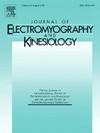横波弹性成像提供可靠的评估刚度在皮肤,筋膜,浅表和深层肌肉组织
IF 2.3
4区 医学
Q3 NEUROSCIENCES
引用次数: 0
摘要
横波弹性成像(SWE)是一种可靠的方法估计刚度的浅股直肌(RF)肌肉在不同的肌肉长度。其可靠性尚未评估在深层肌肉区域或其上的筋膜和皮肤组织。20名健康参与者完成了两次访问,在四个深度(皮肤-皮肤,筋膜- fas,浅表肌肉- sup和深层肌肉- deep)三个位置(松弛- rel,中性- neu和拉伸- str)测量RF剪切波速度(SWV),间隔30分钟。相对信度由类内相关系数确定,绝对信度由标准误差和测量偏差评估。SWE报告了较差到良好的相对日内信度(ICC, 0.33-0.82),但良好到优秀的绝对日内信度(SEM, 0.14-0.25 m/s;偏差,- 0.12-0.07)。相对SWE日间信度为中等至优秀(ICC, 0.54-0.91),绝对信度为良好至优秀(SEM, 0.12-0.21 m/s;偏差,- 0.05-0.06)。体位上STR、NEU、REL的信度最高,皮肤和FAS的信度高于肌肉。SUP测量报告的可靠性高于DEEP。因此,SWE是估计SKIN、FAS、SUP和DEEP RF组织刚度的可靠方法。为了优化可重复性,应从拉伸的表面组织进行测量。本文章由计算机程序翻译,如有差异,请以英文原文为准。
Shear wave elastography provides reliable assessments of stiffness in the skin, fascia, and both superficial and deep muscle tissues
Shear wave elastography (SWE) is a reliable method of estimating stiffness of superficial rectus femoris (RF) muscle at various muscle lengths. Its reliability has not been assessed in deeper muscle regions or its overlying fascia and skin tissue. 20 healthy participants completed two visits in which RF shear wave velocity (SWV) was measured twice, separated by 30mins, at four depths (skin–SKIN, fascia–FAS, superficial muscle–SUP, and deep muscle–DEEP) in three positions (relaxed–REL, neutral–NEU, and stretched–STR). Relative reliability was determined by intraclass correlation coefficients and absolute reliability was assessed by standard error and bias of measurements. SWE reported poor to good relative intra-day reliability (ICC, 0.33–0.82) but good to excellent absolute intra-day reliability (SEM, 0.14–0.25 m/s; bias, −0.12–0.07). Relative SWE inter-day reliability was moderate to excellent (ICC, 0.54–0.91) and absolute reliability was good to excellent (SEM, 0.12–0.21 m/s; bias, −0.05–0.06). Reliability was highest in the order of STR, NEU, REL with regards to position, with SKIN and FAS reliability greater than in muscle. SUP measurements reported greater reliability than DEEP. Therefore, SWE is a reliable method of estimating SKIN, FAS, SUP and DEEP RF tissue stiffness. To optimise repeatability, measurements should be taken from stretched superficial tissue.
求助全文
通过发布文献求助,成功后即可免费获取论文全文。
去求助
来源期刊
CiteScore
4.70
自引率
8.00%
发文量
70
审稿时长
74 days
期刊介绍:
Journal of Electromyography & Kinesiology is the primary source for outstanding original articles on the study of human movement from muscle contraction via its motor units and sensory system to integrated motion through mechanical and electrical detection techniques.
As the official publication of the International Society of Electrophysiology and Kinesiology, the journal is dedicated to publishing the best work in all areas of electromyography and kinesiology, including: control of movement, muscle fatigue, muscle and nerve properties, joint biomechanics and electrical stimulation. Applications in rehabilitation, sports & exercise, motion analysis, ergonomics, alternative & complimentary medicine, measures of human performance and technical articles on electromyographic signal processing are welcome.

 求助内容:
求助内容: 应助结果提醒方式:
应助结果提醒方式:


